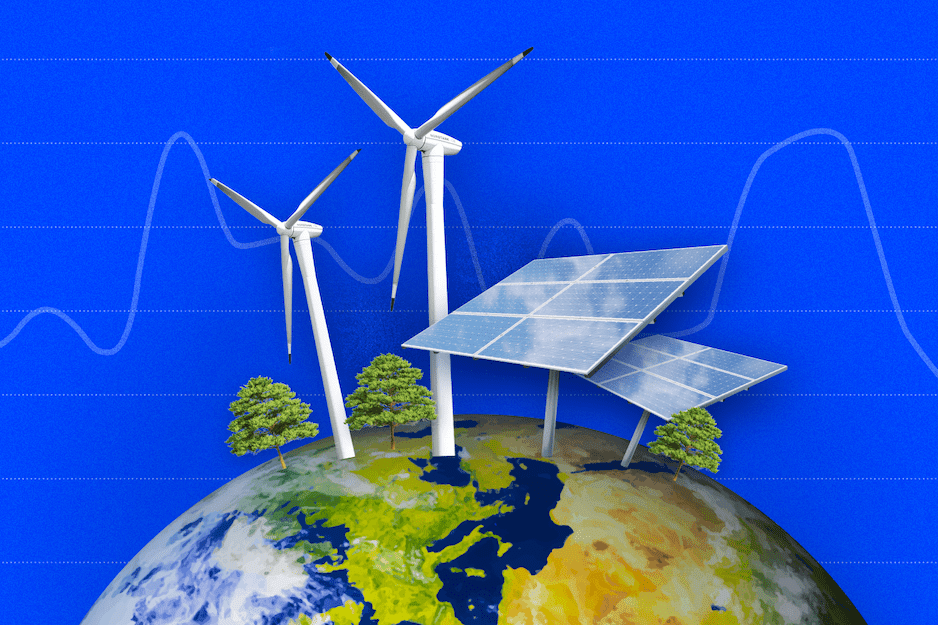The Formula to Net Zero: Decarbonization, Hydrogen, and the Energy Transition
View webinar
Since 2022, the oil industry has faced a series of volatile macroeconomic events that have escalated the importance of renewable energy.
As societal concerns about climate change climb, interest in ESG investing grows, and new global crises destabilize supply chains, stakeholders and private equity are funneling capital into potential energy solutions. Geopolitical events (i.e, COVID-19 pandemic, the Russia-Ukraine war, etc.) have only reminded nations around the world that some sources of fossil fuel are unreliable and that renewable energy initiatives are becoming business-as-usual.
Already, countries are transitioning their infrastructures to rely on clean energy, reducing their carbon footprint, and becoming self-sufficient in fulfilling their energy demands. This international activity of restructuring has forged trends now dominating the renewable energy market and, consequently, booming opportunities for E&I investors.
Using the AlphaSense platform, we dug into how countries and continents are prioritizing sustainability and paving the way for an eco-conscious future.
What’s Driving Interest In Renewable Energy?
The impact of the Russia-Ukraine war has dramatically hindered global supply chains by cutting off their oil supply to the EU union, unintentionally pushing forward the energy transition. In response to Russia’s action, the EU announced a 90% ban on Russian oil by YE22 (with new and existing sanctions imposed), a complete ban on combustion vehicles by 2035, and the REPowerEU Plan—an initiative created in response to the global energy market disruptions caused by Russia’s invasion.
The Plan emphasizes the EU’s top concern to discover and secure new, diverse supplies of energy while also accelerating a roll-out of renewable energy to replace fossil fuels in homes and power generation.
The Organization of the Petroleum Exporting Countries Plus’s (OPEC+) recent decision to cut oil production by two million barrels per day this past November has had similarly devastating consequences.
OPEC’s influence on global economic markets is immeasurable, as the group consists of the 23 largest oil-exporting countries and produces around 30% of the world’s crude. Diplomatic frustration has potentially been apparent in Washington, as some Congress members see OPEC+’s decision as a means to funnel financial support for Russia (i.e., the communist country is reportedly spending $900 million a day to invade Ukraine and heavily depends on revenues from its gas and oil exportations).
And in the US, Biden released millions of crude barrels from the nation’s Strategic Petroleum Reserve (SPR) and onto the market in October of 2023 to tame rising gas and energy prices as well as compensate for the lack of imported oil. The strategy has consequently depleted the Reserve’s levels to its lowest since 1984.
Renewable Energy Trends Around the World
While the OPEC+ cutback and Russia-Ukraine war have done more damage than good, the crises have forced nations to dig deeper into their impact on the environment and how they can supply their own energy needs in a sustainable manner. From utilizing natural gas, renewable electricity to constructing turbines, there are countless methods by which countries and continents are harvesting energy.
Below, we found the trends currently leading the renewable energy transitions around the world:
China
China‘s carbon emissions are comparatively high compared to other nations, emitting roughly 30% of all global emissions. The country has pledged to reach 100% decarbonization by 2060, but reaching these goals will require a huge level of financial investment to no longer rely on pollutant energy sources like fossil fuels.
According to the Carbon Brief, China has been investing heavily in renewable energy and electricity generation over the past decade, with the country being the largest producer of hydroelectric power. In addition, the country is relying on other renewable energy resources like wind (13.8 percent), solar (12.9 percent), and biomass (1.6 percent).
China‘s insufficient reserves of fossil fuels and the government’s growing need for energy independence have been the main drivers behind the role hydropower plays in the country. China‘s potential power capacity is estimated at up to 400 GW–if reached, China would produce more renewable energy than the United States.
India
To date, India consumes roughly 4.92 million barrels per day, accounting for 5% of the world’s total share, according to the US Energy Information Administration. In fact, the country outpaces almost every other country in the world in terms of oil needs, as Indonesia imported 85% of its crude oil last year alone.
These consumption figures have forced India to target reducing the carbon intensity of the nation’s economy by less than 45% by the end of the decade. To reach these pledges, India intends to achieve 50% cumulative electric power installed by 2030 and reach net-zero carbon emissions by 2070. Looking ahead, investors are forecasting low-carbon energy technologies to hold a market value worth up to $80 billion in India by 2030.
Europe
The Russia-Ukraine war ushered in Europe‘s ongoing energy crisis, requiring the European Union to take immediate action and expedite the REPowerEU Plan.
Solar energy, a major area of the Plan’s focus, is the source of energy that is growing at the highest pace in the EU. In 2020, the EU solar market grew by 18 GW, and 5.2% of the EU’s total electricity production came from solar energy. Not only is solar energy clean, but its cost has decreased by 82% over the last decade, making it the most competitive source of electricity in many parts of the EU.
And there’s already been an increased usage of solar power, with the World Economic Forum reporting that ten EU countries now generate at least 10% of their electricity from the sun. The Netherlands, Germany, and Spain are the EU’s highest solar users, generating 22.7%, 19.3%, and 16.7% of their electricity from solar PV technology and saving the continent $29 billion this past summer in doing so.
USA
The United States has already made impressive progress in its energy transition, with renewable energy resources accounting for 20% of all electricity generated.
In 2022, solar and wind are estimated to contribute over 60% of the utility-scale generating capacity to the country’s power grid—46% will derive from solar while 17% will come from wind. Unlike neighboring nations in North America, the United States has an abundance of renewable energy resources, possessing an amount available that is 100 times greater than the nation’s annual electricity need.
Tapping into domestic resources has allowed the country to double renewable energy‘s share in just a decade—from 10% in 2010 to 20% in 2020. These staggering percentages of growth can be attributed to solar and wind energy, which saw compound annual growth rates of 84% and 15%. Although significant, the United States will have to increase dependency on these resources to achieve its clean energy goals of being 100% Carbon Pollution-Free Electricity by 2030 and 100% Zero-Emission Vehicle Acquisitions by 2035.
Middle East
In regard to renewable energy resources, the Middle East heavily consumed thermal energy over the past few years. In fact, geothermal energy accounted for 90% of the region’s total energy consumption in 2021, with the main source of fuel being natural gas. However, emerging efforts to eliminate fossil fuels reliance have slowed significantly due to Russia’s invasion of Ukraine (more specifically, the communist country is the world’s largest pipeline natural gas exporter).
The sanctions placed on Russia have opened up new natural gas production opportunities in the Middle East, as some experts project a significant spike in production in the coming decade for Middle Eastern countries. Conversely, oil-fired generation capacity is expected to decline by nearly 30% in 2030, which speaks directly to the region’s commitment to lower carbon fuel emissions. The United Arab Emirates, Oman, and Israel have pledged to be net zero by 2050, while Saudi Arabia and Bahrain have declared a net zero target for 2060.
Australia
According to a recent report from Green Energy Markets, New South Wales (NSW)–the largest electricity generator in Australia—is facing significant obstacles in bridging the disparity between its targeted emissions reduction goals for 2030 and its current rate of renewable energy adoption. Without intervention, Australia’s ability to meet its national emission targets (an 82% renewables target by 2030 as well as an 43% emissions reduction target) could be jeopardized.
The projected electricity infrastructure plan of NSW indicates a requirement to produce 33,600 gigawatt hours of renewable energy from operational projects by the end of 2029. However, at the end of 2023, NSW had only achieved a forecasted output of about 12,911GWh from projects either committed or contracted. This output stemmed from projects with a combined capacity of just over 6GW, leaving a substantial gap of nearly 7.5GW in wind and solar farms necessary to fulfill the target.
Queensland faced a deficit in capacity of approximately 2.6GW, despite a recent surge in approvals that the report described as “remarkable.” South Australia also fell short, with a deficit of 2.445GW while Victoria was inching closer to its target of achieving 65% renewables by 2030—requiring less than 1GW to meet its goal. In contrast, Western Australia had already secured sufficient projects through construction, contracts, or government funding to meet its renewable energy target.
NSW is seen as the unofficial leader for the national shift-away from fossil fuels. But despite experiencing relatively limited strains on its power grid during this summer, with heat waves confined mostly to single-day occurrences in major population centers like Sydney, NSW could face significant obstacles in its transition to renewable energy in the near future.
For example, the impending closure of Eraring, Australia’s largest coal-fired power station with a capacity of 2.88GW, scheduled for August 2025, presents a significant hurdle. Eraring’s closure is expected to remove approximately a quarter of NSW’s baseload generation capacity, further complicating the state’s energy landscape. These shortcomings led experts to urge developers and legislators to reassess their approach and ease off on pushing for rapid changes.
Growing Competition for Renewable Resources
As the US ramps up efforts to establish a domestic solar power manufacturing industry, new legislation has been introduced to thwart the competition. This past August, US lawmakers finalized a decision to impose import duties on solar panel makers who finished their products in Southeast Asian nations to avoid tariffs on Chinese-made goods.
The decision, which largely mirrors a preliminary finding the agency made in December, was opposed by buyers of solar panels who rely on cheap products made overseas to make their projects competitive.
A US Department of Commerce probe found that units of Chinese companies (i.e., BYD, Trina Solar, Vina Solar, and Canadian Solar) were avoiding tariffs on Chinese solar cells and panels by using minor processes to “finish” products in Cambodia, Malaysia, Thailand, and Vietnam—countries that account for about 80% of U.S. panel supplies.
Going forward, other companies operating in those nations can pursue certification to show that they are not circumventing tariffs. To become certified, solar cells and panels must contain non-Chinese wafers and three other key components.
Ultimately, this is good news for the small U.S. solar manufacturing industry, which for years has struggled to compete with Chinese goods and is enjoying renewed investment due to subsidies in U.S. President Joe Biden’s landmark climate-change law.
Renewable Energy Outlook for 2024
As countries and continents reduce their greenhouse gas emissions and rely less on toxic forms of energy, the net-zero and environmentally-conscious pledges nations have committed are proving to create more than just energy security.
Most are also seizing the opportunity to establish themselves as leaders of renewable energy products, whether it be water, wind, solar, or biomass power. These avenues of generating energy will allow countries to develop an emerging, competitive market that was once only exclusive to fossil fuel, carbon-emitting exporters.
How the competition will unfold largely depends on the speed and efficiency of these countries’ transition to renewable energy resources.
Monitoring short- and long-term progress will be vital in determining where investor return will be highest in this international race. And tracking progress can be a full-time job, which is why more and more energy industry professionals are turning to market intelligence platforms to keep tabs and make more informed strategic moves.
How to Stay On Top of Renewable Energy Trends
An increasing number of C-Suite executives are implementing market intelligence and search platforms into their operations to find the answers they need and act swiftly. But not every market intelligence platform provides measurable ROI, which is why it’s important to select one that fits your needs.
AlphaSense’s AI search technology and extensive content library, which aggregates business documents from over 10,000 content sources, allow our clients to remain at the forefront of their respective industries.
Start your free trial with AlphaSense today to see how our platform can keep you at the forefront of the power sector.




